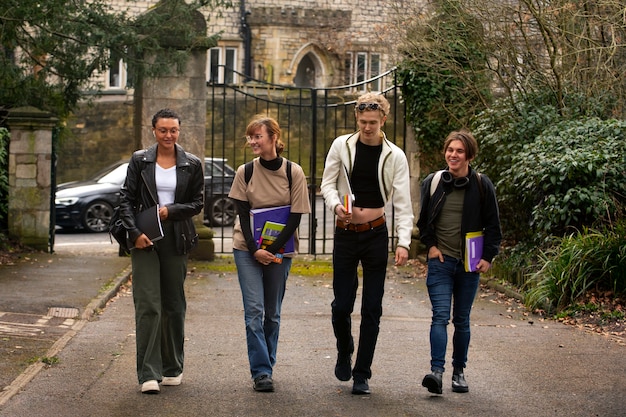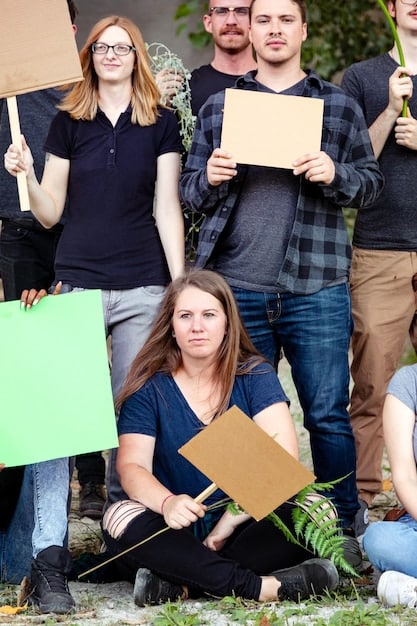Affirmative Action Ruling: College Enrollment Trends in the Next 3 Years

The Impact of the Supreme Court’s Affirmative Action Ruling is expected to reshape college enrollment trends over the next three years, potentially decreasing diversity in higher education institutions and prompting new strategies for equitable admissions.
The recent Supreme Court decision to end affirmative action in college admissions has sent shockwaves through the higher education landscape. The coming years will reveal the true extent of the impact of the Supreme Court’s Affirmative Action Ruling: A Look at College Enrollment Trends in the Next 3 Years, as institutions grapple with new enrollment strategies and students navigate a changed admissions process.
Understanding the Supreme Court’s Decision on Affirmative Action
The Supreme Court’s ruling against affirmative action dismantled decades of precedent, effectively barring colleges and universities from considering race as a specific factor in admissions decisions. This decision was based on the argument that affirmative action policies violated the Equal Protection Clause of the Fourteenth Amendment.
The Legal Basis for the Ruling
The Court argued that race-conscious admissions policies were inherently discriminatory and perpetuated racial classifications. The majority opinion emphasized that all applicants should be treated equally, regardless of their race or ethnicity. The ruling cited that the previous standards for affirmative action were too vague and did not provide a clear end point, thereby making them unconstitutional.
Dissenting Opinions and Concerns
Dissenting justices raised concerns about the potential for decreased diversity in higher education and the perpetuation of historical inequalities. They argued that affirmative action was a necessary tool to address systemic disadvantages faced by underrepresented minority groups. Some dissenting opinions highlighted the potential for the ruling to exacerbate existing disparities in access to higher education.

The decision also raises important questions about what aspects of an applicant’s background can still be considered. It is allowable for students to discuss in their applications how race affected their lives, so long as that discussion is tied to a quality or characteristic the student can contribute to the university. This has been interpreted as permitting discussion of race but not using race as a determining factor for acceptance.
The full impact of these adjustments on the entire system remains to be seen. Will new methods succeed in promoting diversity, or will they fall short of the goals that affirmative action once sought to achieve? The next few years will be telling.
Potential Impacts on College Enrollment Demographics
The immediate aftermath of the Supreme Court ruling has led to significant speculation about how college enrollment demographics might shift. Many experts predict a decline in the enrollment of underrepresented minority students, particularly at highly selective institutions.
Projected Enrollment Declines for Minority Groups
Studies and historical data suggest that bans on affirmative action in states like California and Michigan led to decreased enrollment rates among Black and Hispanic students. Experts worry that the nationwide ban could replicate these trends on a broader scale, potentially reversing years of progress in diversifying college campuses.
Shifts in Enrollment at Elite Institutions
Elite institutions, which have historically relied on affirmative action to build diverse student bodies, may face the most significant challenges. These schools could see a decrease in the representation of underrepresented minority groups, potentially altering campus culture and academic discourse.
- Geographic diversity: Colleges may focus on recruiting from a wider range of geographic locations, including rural and underserved areas.
- Socioeconomic status: Increased emphasis on socioeconomic status could help identify talented students from disadvantaged backgrounds, irrespective of their race.
- Holistic review: Colleges are likely to refine their holistic review processes to consider a broader range of factors, such as leadership skills, community involvement, and personal experiences.
These strategies aim to provide all students with opportunities to demonstrate their potential and connect with institutions where they can thrive.
Strategies Colleges Are Adopting in Response
In response to the Supreme Court ruling, colleges and universities are exploring alternative strategies to maintain diversity on their campuses. These strategies range from revising admissions policies to enhancing outreach programs to underrepresented communities.

Revising Admissions Policies
Many institutions are reevaluating their admissions policies to ensure they are fair and equitable while still considering the applicant’s background and experiences. This includes placing greater emphasis on socioeconomic factors, improving holistic review processes, and eliminating legacy preferences.
Expanding Outreach and Recruitment Efforts
Colleges are also ramping up their outreach and recruitment efforts in underrepresented communities, investing in programs that provide academic support, mentoring, and college preparation resources to students from disadvantaged backgrounds. These efforts aim to create a more level playing field and encourage a wider range of students to apply.
Financial Aid and Scholarship Programs
Enhancing financial aid and scholarship programs is another critical strategy. By providing more generous financial assistance to low-income students, colleges can make higher education more accessible to those who might otherwise be unable to afford it. These programs can also help attract diverse students from a wide range of socioeconomic backgrounds.
These strategies show that while the end of affirmative action may present changes, educational institutions are proactive in ensuring diversity remains a key aspect of campus life. The outcomes of these initiatives will be influential in shaping the future composition of student bodies and the overall fairness of the higher education system.
The Role of Standardized Testing in the Post-Affirmative Action Era
The role of standardized testing, such as the SAT and ACT, has come under increased scrutiny in the wake of the affirmative action ruling. Many argue that these tests are biased and perpetuate inequalities, while others maintain they provide a valuable measure of academic aptitude.
Arguments for Test-Blind Admissions
Proponents of test-blind admissions argue that standardized tests are not accurate predictors of college success and that they disproportionately disadvantage students from low-income and underrepresented backgrounds. Studies have shown that test scores are often correlated with socioeconomic status, raising concerns about fairness and equity.
The Continued Importance of Standardized Tests
On the other hand, some educators and policymakers believe standardized tests provide a useful tool for evaluating applicants, particularly at large and highly competitive institutions. They argue that tests offer a standardized measure of academic ability that can be compared across different high schools and educational backgrounds.
- Test-optional policies:Allowing students to choose whether to submit their scores.
- Contextualized testing: Interpreting scores within the context of the student’s background and circumstances.
- Focusing on other factors: Placing greater emphasis on grades, essays, and extracurricular activities.
These adjustments show a move towards more balanced approaches in assessing student potential.
The debate over standardized testing is likely to continue in the coming years, as colleges and universities grapple with how to create fair and equitable admissions processes. As they refine their approaches, the impacts on the diversity and inclusivity of college campuses will continue to be seen.
Legal Challenges and Future Litigation
The Supreme Court’s decision is not the final word on affirmative action. Legal challenges and future litigation are likely to emerge as various stakeholders test the boundaries of the new legal landscape. These challenges could focus on issues such as the consideration of socioeconomic factors, the use of holistic review processes, and the implementation of outreach programs.
Potential Legal Challenges to Alternative Admissions Strategies
Some legal experts predict that alternative admissions strategies, such as prioritizing socioeconomic status or considering applicants’ personal experiences with race, could face legal challenges if they are deemed to be a disguised attempt to achieve racial quotas. The courts may scrutinize these policies to ensure they are genuinely race-neutral and do not violate the Equal Protection Clause.
The Role of the Department of Education
The Department of Education could play a significant role in shaping the implementation of the Supreme Court’s ruling. The agency could issue guidance to colleges and universities on permissible admissions practices and provide oversight to ensure compliance with federal law. The Department may also investigate complaints of discrimination or unlawful admissions policies.
These legal actions will continue to shape the conversation around fairness in education, and their outcomes could redefine the balance of opportunity for different demographic groups.
Long-Term Implications for Society and the Workforce
The long-term implications of the Supreme Court’s decision extend beyond college campuses, potentially affecting society and the workforce. Some worry that decreased diversity in higher education could lead to a less diverse and representative leadership in various sectors.
Impact on Leadership and Representation
If underrepresented minority groups are less likely to access elite educational institutions, they may face barriers to leadership positions in business, politics, and other fields. This could perpetuate existing inequalities and limit the perspectives and experiences that shape decision-making processes.
Economic and Social Consequences
Decreased diversity in the workforce could have economic and social consequences. Studies have shown that diverse teams are more innovative and productive. A less diverse workforce might stifle creativity and limit economic opportunities for underrepresented groups.
This discussion makes it increasingly clear that the effects of the affirmative action ruling could reach far beyond educational boundaries. They have the capacity to restructure society’s leadership and shape economic opportunities, which will therefore depend on the innovative approaches that educational institutions have implemented in response.
| Key Point | Brief Description |
|---|---|
| ⚖️ Supreme Court Ruling | Ended affirmative action in college admissions. |
| 📉 Enrollment Impact | Potential decline in minority student enrollment. |
| 🎓 College Strategies | Revising policies, enhancing outreach, and boosting financial aid. |
| 🧪 Testing Debate | Arguments over test-blind policies and standardized testing validity. |
[FAQ Section]
What was the Supreme Court’s ruling on affirmative action?
▼
The Supreme Court ruled against affirmative action, barring colleges from using race as a determining factor in admissions, citing the Equal Protection Clause of the Fourteenth Amendment.
▼
Experts predict a potential decline in the enrollment of underrepresented minority groups, particularly at elite institutions, based on trends observed in states that previously banned affirmative action.
▼
Colleges are revising admissions policies, expanding outreach, enhancing financial aid programs, and reevaluating the role of standardized testing to maintain diversity.
What is the role of standardized testing in the post-affirmative action era?
▼
The role of standardized testing is being debated, with some advocating for test-blind admissions and others arguing for the continued importance of tests as a measure of academic aptitude.
▼
There are concerns that decreased diversity in higher education could lead to a less diverse leadership in various sectors and have potential economic and social consequences due to stifled innovation.
Conclusion
The Supreme Court’s decision on affirmative action marks a significant turning point in higher education. While the immediate effects are still unfolding, it is clear that colleges and universities must adapt to this new reality by developing innovative enrollment strategies and fostering inclusive campus environments. The coming years will be critical in determining whether these policies can effectively promote diversity and opportunity for all students.





